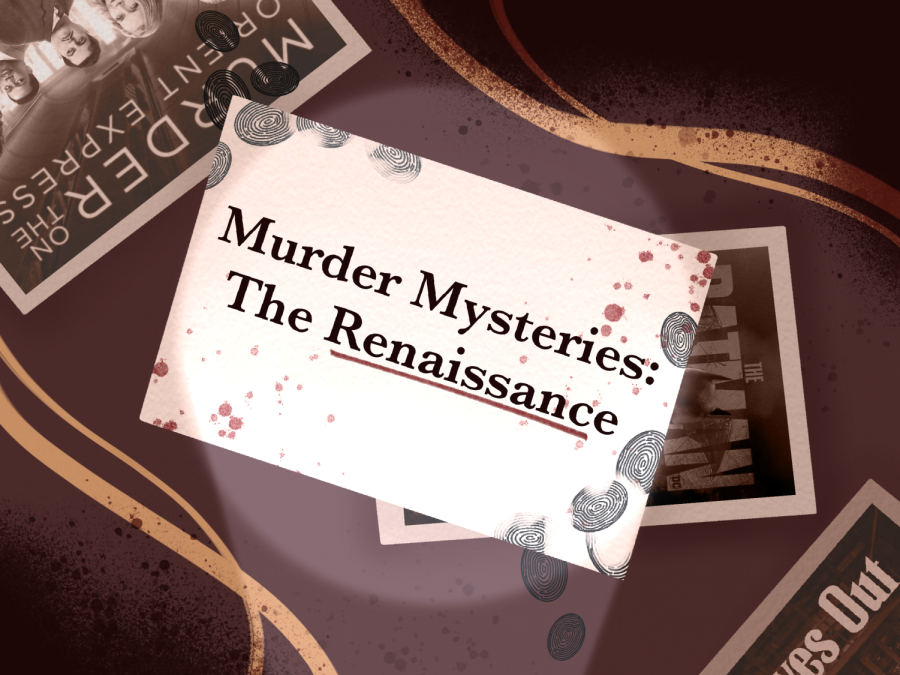The Renaissance of Murder Mystery Films
Staff Writer Katharine Manson delves into the revival of detective films in American cinema and its importance to the art of storytelling.
Warning: This article contains minor spoilers for the plot of “Knives Out,” “The Batman,” “Murder On The Orient Express” and “Death On The Nile”.
With “Glass Onion: A Knives Out Mystery” and many more films on the horizon, it begs the question; when did murder mysteries get so popular again? As of the late 2010s, the murder mystery genre of American films is experiencing a comeback, reintroducing satisfying plot twists and reminding audiences about the power of crafting puzzles using cinematography.
Box office hits such as “Murder On The Orient Express,” “Knives Out” and even “The Batman” have left their mark on the world of cinema for the same reason: distinctive style, camerawork and one-of-a-kind plotlines. The detailed and complex narratives force the audience to piece together clues, pulling them deeper into the film and amping up the tension. More often than not, a profound message is carefully embedded throughout the sleuthing, nicely tying up endings to plots that only span a single movie.
Successful detective films have proven time and time again the importance of forming connections with the audience through every character, regardless of if they’re the victim, investigator or suspect. In recent cinematography, the movie adaptation of “Murder On The Orient Express” crafted compelling backstories and perspectives. When meeting each suspect, it’s easy and tempting to see how anyone could be the perpetrator, even with little evidence. The film builds up to one of the most unique plot twists in mystery cinema through well-placed dialogue and symbolic camerawork, with closeups of subtle body language and flashbacks hinting at the plot’s climactic finale.
In its sequel, “Death On the Nile,” the movie takes it one step further by engaging the viewers to think past their assumptions and bias to piece together the bigger picture. When the primary suspect is killed right before his eyes, it’s revealed Hercules Poirot missed crucial details and made assumptions that could have been avoided. Screenwriters often have the detective make mistakes due to implicit bias — an issue in real criminal investigations — and show why they have to operate with an objective point of view.
There’s a sense of wonder and intrigue that can only be found in these iconic films, and the evolving creativity of filmmakers in how they tell their stories only enhances the audience’s immersion. Artistic choices such as integrating multiple perspectives or telling the story out of order have only gotten more common. Dark comedy and mystery, “Knives Out” starring detective Benoit Blanc masterfully subverts audience expectations for a unique and suspenseful story. Scenes of high-intensity showcase loud noises, uncomfortable close-ups and flashbacks to previous memories emphasize stress and pressure. The cinematography of the film is a contemporary homage to early radio shows such as Sherlock Holmes or the Lone Ranger, switching between the perspectives of the suspect and the investigator.
“The Batman” is a stellar example of tying in the mystery to the characters. Despite being a superhero film, it carries the hallmarks of the noir detective genre — with a dark twist. As Batman furthers his investigation into the corruption of the Gotham City Police Department, the audience gets a glimpse into his motivations and evolution to becoming a hero. The film is not just about the murders and the drama, but about the people who solve these issues, much like how Blanc and Poirot’s films show their integrity and their commitment to justice. Side characters are fleshed out and add their own skills to the case, simultaneously reinforcing the mystery and the worldbuilding.
These movies are heralding a new cinematic era of detective mysteries, but their strategy for reviving this previously dormant genre isn’t particularly unique — they are simply drawing inspiration from the past. There is a greater emphasis on the filming techniques and visual effects that purposefully avoid overdoing scenes for the eyes of the audience. Each film carefully lays out an elaborate plot that they never once deviate from right up until the credits; a cohesive narrative despite all the twists and turns. And every character gets to be featured, they all have a purpose to the plot and there is no room for a throwaway gag character when the mystery has yet to be solved.
By creating unique and captivating lead figures that present the evidence of the crimes to the audience to solve along with them, along with modern film techniques and ideas, the film industry has renewed interest in a dormant genre of American cinema. The rebirth of classical filmwork — it’s truly a perfect renaissance.




